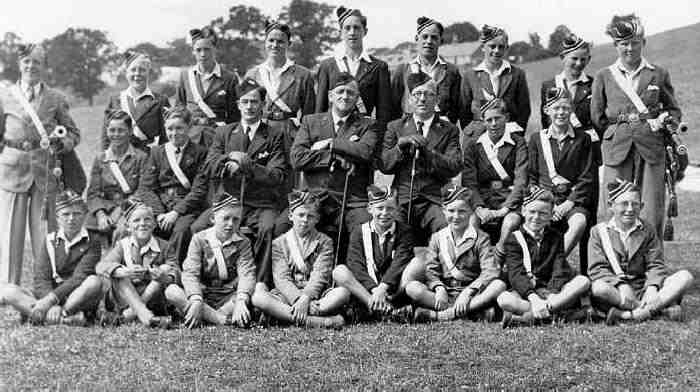
Figure 1.--This image shows a Boys' Brigade camp in 1949. We believe it is an English camp, but it could be Scottish. We see bagpipes, but no kilts. We do not know where the camp was held. Note that the boys wear suits even though they are at camp. |

|
The Boys Brigade originated in Scotland. It was the first uniformed youth orgaisation in the world. The organization originally addressed the needs of low income boys in the late 19th Century. There was limited options for healthy activities. Juvenile delinquency was rising. Sir William Alexander Smith founded the Boy's Brigade in Scotland to address these needs (1883). The organization spread to England, although here we have few details. We do know that it was well-established in England by the 1900s. It was at this time that Brigade leaders persued the idea of creating a Scouting program wiythin the organization. Leaders turned to Riber Baden Powell. The founding of the Boy' Brigade predated the Boy Scouts by two decades. While Scouting was initially conceived as a adjunct to the Boys' Brigade, it soon developed a momentum of its own. The interests of Scouts and the Boy's Brigade was different as was the program. The Boys' Brigade has continued to focus on religion.
The Boys Brigade originated in Scotland. It was the first uniformed youth orgaisation in the world. The organization originally addressed the needs of low income boys in the late 19th Century. There was limited options for healthy activities. Juvenile delinquency was rising. Sir William Alexander Smith founded the Boy's Brigade in Scotland to address these needs (1883). The quickly organization spread to England, although here we have few details. ThevBrigade did not have a uniform, but only a destinctive pillbox cap and white shoulder strap. The shoulder belt was a military style. The shoulder strap provide support for a waist belt carrying heavy military equipment. For the Brigade it was primarily a decortive item that provided an inexpensive way of creating what looks like a uniform.
We conyimnue to see the basic approach to uniform, just a cap and white shoulder strap. We note a portrait of two unidentifid brothers wearing suits and ties with the pill box caps worn at an angle, white shoulder straps and white belt pouch, and belts with the Brigade buckle. The portrait was a cabinet card. The older brother was an officer with an extra shoulder strap and round badge. The boys look to be about 11-15 years old. The portrait is undated but the pinking suggests the portrait was taken in the early-1890s. Very commonly the boys wore suits not any kind of practical activity unifirm like the Boy Scouts would adopt. This reflcted the activity program of the two groups. The Brigade at the time had a much less extensive activity program with no emphasis on outdoor activuties and camping. The scouts woukd grow out of he Brigade with less emphasis on religion and a more active outdoor program.
We do know that it was well-established in England by the 1900s. It was at this time that Brigade leaders pursued the idea of creating a Scouting program wiythin the organization. Leaders turned to Robert Baden Powell. The founding of the Boy' Brigade predated the Boy Scouts by two decades. While Scouting was initially conceived as an adjunct to the Boys' Brigade, it soon developed a momentum of its own. The interests of Scouts and the Boys' Brigade was different as was the program. The Boys' Brigade has continued to focus on religion to a greater extent than the Scouting movement. A good period view of the Boys Brigade comes from a postcard showing a crowd of people watching the Boys Brigade marching down Pelham Crescent, Hastings.
The Boys' Brigade continued tonhave the same uniform in the 1910s. Images we have found fromthe 10s shows the boys wearing the pill-box cap and white bekt with a shoulder strap. The boys normally wear these two itemsxwith suits. This demonstrates the principal difference with Scouting. Scouting was an outdoor pursuits progeam with a Christian component. The Scout uniform was designed for such an active orogram. The Boys Brigade had a much smaller ouitdoors pursuits component and wearing suits showed this. The suits were ot precisely part of the uniform, but so many of the boys wear suits that it is obvious that it wa clerly expected, almost as if they were going to a church service. We note a 1913 portrait from Horsforth, Leeds shoeing a boys' Brigade unit. In the front row or a drum anf buggel unit.
This image shows a Boys' Brigade camp in 1949 (figure 1). We believe it is an English camp, but it could be Scottish. We see bagpipes, but no kilts. We do not know where the camp was heald. Note that the boys wear suits even though they are at camp. They seem to be wearing a new campaign cap instead of the old pill-box styled caps. Theuyy still have the white belts.
Navigate the Historic Boys' Uniform Chronology Pages:
[Return to the Main chronologies page]
[The 1900s]
[The 1910s]
[The 1920s]
[The 1930s]
[The 1940s]
[The 1950s]
[The 1960s]
[The 1970s]
[The 1980s]
[The 1990s]
[The 2000s]
Navigate the Historic Boys' Uniform Web Site:
[Introduction]
[Activities]
[Biography]
[Chronologies]
[Countries]
[Essays]
[Garments]
[Organizations]
[Other]
[Bibliographies]
[Contributions]
[FAQs]
[Questions]
[Unknown images]
[Boys' Uniform Home]
Navigate the Historic Boys' Uniform Web Boys Brigade pages:
[Return to the Main Boys' Brigade Page]
[Australia]
[England]
[New Zealand]
[Scotland]
